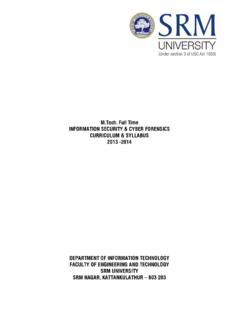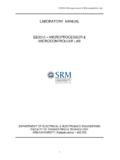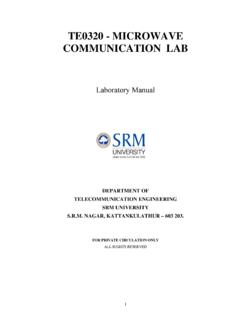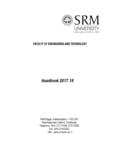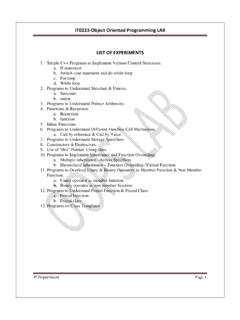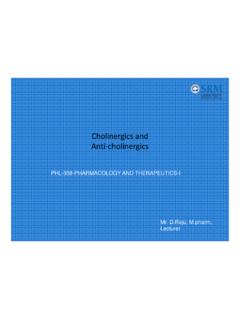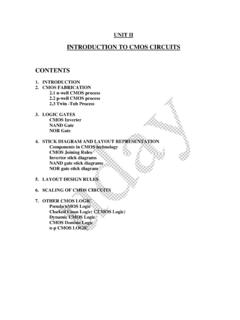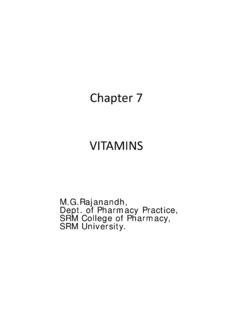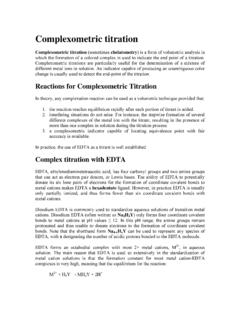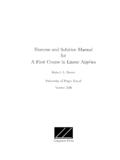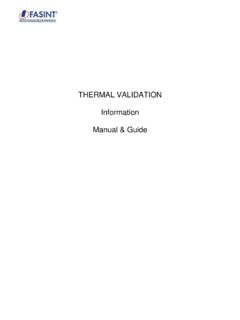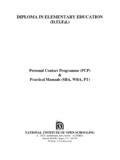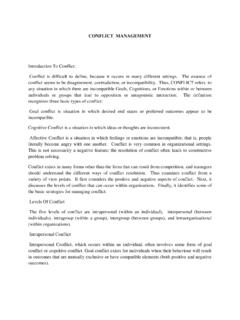Transcription of ANIMAL CELL AND TISSUE CULTURE MANUAL
1 ANIMAL CELL AND TISSUE CULTURE MANUAL For the course of BT 0312 ANIMAL CELL AND TISSUE CULTURE LABORATORY Offered to III YEAR , BIOTECHNOLOGY DEPARTMENT OF BIOTECHNOLOGY SCHOOL OF BIOENGINEERING SRM UNIVERSITY KATTANKULATHUR INDEX NAME OF THE EXPERIMENT PAGE NO. DATE OF EXPERIMENT REMARK 1 Sterilization Techniques 2 Preparation of Media 3 Preparation of Sera 4 Primary Cell CULTURE 5 Preparation of established Cell lines 6 Cell Counting and Viability 7 Staining of ANIMAL Cells 8 Preservation of Cells 9 CULTURE of Virus in Chick Embryo 10 Adaptation of Virus in ANIMAL (in vitro) Cell CULTURE 11 DPPH radical scavenging assay LABORATORY SAFETY GENERAL RULES AND REGULATIONS A rewarding laboratory experience demands strict adherence to prescribed rules for personal and environmental safety.
2 The former reflects concern for your personal safety in terms of avoiding laboratory setting to prevent contamination of experimental procedures by microorganisms from exogenous sources. Because most microbiological laboratory procedures require the use of living organisms, an integral part of all laboratory session is the use of aseptic techniques. Although the virulence of microorganisms used in the academic laboratory environment has been greatly diminished because of their long-term maintenance on artificial media, all microorganisms should be treated as potential pathogens (organisms capable of producing disease). Thus, microbiology students must develop aseptic techniques (free of pathogenic organisms) in preparation for industrial and clinical marketplaces where manipulation of infectious organisms may be the norm rather than the exception. The following basic steps should be observed at all times to reduce the ever-present microbial flora of the laboratory environment.
3 1. Upon entering the laboratory, place coast, books, and other paraphernalia in specified locations-never on bench tops. 2. Keep doors and windows closed during the laboratory session to prevent contamination from air currents. 3. At the beginning and termination of each laboratory session, wipe bench tops with a disinfectant solution provided by the instructor. 4. Do not place contaminated instruments, such as inoculating loops, needles, and pipettes, on bench tops. Loops and needles should be sterilized by incineration, and pipettes should be disposed of in designated receptacles. 5. On completion of the laboratory session, place all cultures and materials in the disposal area as designated by the instructor. 6. Rapid and efficient manipulation of fungal cultures and materials in the disposal area as designated by the instructor. 7. Rapid and efficient manipulation of fungal cultures is required to prevent the dissemination of their reproductive spores in the laboratory environment.
4 To prevent accidental injury and infection of yourself and others, observe the following regulations at all times: 1. Wash your hands with liquid detergent and dry them with paper towels upon entering and prior to leaving the laboratory. 2. Wear a paper cap or tie back long hair to minimize its exposure to open flames 3. Wear a lab coat or apron while working in the laboratory to protect clothing from contamination or accidental discoloration by staining solutions. 4. Closed shoes should be worn at all times in the laboratory setting. 5. Never apply cosmetics or insert contact lenses in the laboratory. 6. Do not smoke, eat, or drink in the laboratory. These activities are absolutely prohibited. 7. Carry cultures in a test - tube rack when moving around the laboratory. Likewise, keep cultures in a test-tube rack on the bench tops when not in use. This serves a dual purpose to prevent accidents and to avoid contamination of yourself and the environment.
5 8. Never remove media, equipment, or especially, bacterial cultures from the laboratory. Doing so is absolutely prohibited. 9. Immediately cover spilled cultures or broken cultures tubes with paper towels and then saturate them with disinfectant solution. After 15 minutes of reaction time, remove the towels and dispose of them in a manner indicated by the instructor. 10. Report accidental cuts or burns to the instructor immediately. 11. Never pipette by mouth any broth cultures or chemical reagents. Doing so is strictly prohibited. Pipetting is to be carried out with the aid of a mechanical pipetting device. 12. Do not lick labels. Use only self-stick labels for the identification of experimental cultures. 13. Speak quietly and avoid unnecessary movement around the laboratory to prevent distractions that may cause accidents. The specific precautions outlined below must be observed when handling body fluids of unknown origin due to the possible imminent transmission of the HIV and hepatitis B viruses in these test specimens.
6 1. Disposal gloves must be worn during the manipulation of these test materials. 2. Immediate hand washing is required if contact with any of these fluids occurs and also upon removal of the gloves. 3. Masks, safety goggles, and laboratory coast should be worn if an aerosol might be formed or splattering of these fluids is likely to occur. 4. Spilled body fluids should be decontaminated with a 1:10 dilution of household bleach, covered with paper toweling, and allowed to react for 10 minutes before removal. 5. Test specimens and supplies in contact with these fluids must be placed into a container of disinfectant prior to autoclaving. I have read the above laboratory safety rules and regulations and agree to abide by them. LABORATORY PROTOCOL Student preparation for laboratory sessions The efficient performance of laboratory exercises mandates that you attend each session fully prepared to execute the required procedures.
7 Read the assigned experimental protocols to effectively plan and organize the related activities. This will allow you to maximize use of laboratory time. PREPARATION OF EXPERIMENTAL MATERIALS Microscope Slides Meticulously clean slides are essential for microscopic work. Commercially precleaned slides should be used for each microscopic slide preparation. However, wipe these slides with dry lens paper to remove dust and finger marks prior to their use. Labeling of CULTURE vessels Generally, microbiological experiments require the use of a number of different test organisms and a variety of CULTURE media. To ensure the successful completion of experiments, organize all experimental cultures and sterile media at the start of each experiment. Label CULTURE vessels with non- water- soluble glassware markers and / or self - stick labels prior to their inoculation. The labeling on each of the experimental vessels should include the name of the test organisms, the name of the medium, the dilution of sample, if any, your name or initials, and the date.
8 Place labeling directly below the cap of the CULTURE tube. When labeling Petri dish cultures, only the name of the organism(s) should be written on the bottom of the plate, close to its periphery, to prevent obscuring observation of the results. The additional information for the identification of the CULTURE should be written on the cover of the Petri dish. Inoculation Procedures Aseptic techniques for the transfer or isolation of microorganisms, using the necessary transfer instruments is described fully in the experiments in Part I of the MANUAL . Technical skill will be acquired through repetitive practice. Inoculating Loops and Needles It is imperative that you incinerate the entire wire to ensure absolute sterilization. The shaft should also be briefly passed through the flame to remove any dust or possible contaminants. To avoid killing the cells and splattering the CULTURE , cool the inoculating wire by tapping the inner surface of the CULTURE tube or the Petri dish cover prior to obtaining the inoculum.
9 When performing an aseptic transfer of microorganisms, a minute amount of inoculum is required. If an agar CULTURE is used, touch only a single area of growth with the inoculating wire to obtain the inoculum. Never drag the loop or needle over the entire surface, and take care not to dig into the solid medium. If a broth medium is used, first tap the bottom of the tube against the palm of your hand to suspend the microorganisms. Caution: Do not tap the CULTURE vigorously as this may cause spills or excessive foaming of the CULTURE , Which may denature the proteins in the medium. Pipettes Use only sterile, disposable pipettes or glass pipettes sterilized in a canister. The practice of pipetting by mouth has been discontinued to eliminate the possibility of auto-infection by the accidental imbibement of the CULTURE or infectious body fluids. Instead, a mechanical pipetting device is to be used to obtain and deliver the material to be inoculated.
10 Incubation Procedure Microorganisms exhibit a wide temperature range for growth. However for most used in this MANUAL , optimum growth occurs at 370C over a period of 18 to 24 hours. Unless otherwise indicated in specific exercise, incubate all cultures under the conditions cited above. Place CULTURE tubes in a rack for incubation. Petri dishes may be stacked; however, they must always be incubated in an inverted position (top down) to prevent water of condensation from dropping onto the surface of the CULTURE medium. This resultant excess moisture may then serve as a vehicle for the spread of the micro-organisms on the surface of the CULTURE medium, thereby producing confluent rather than discrete microbial growth. PROCEDURE FOR RECORDING OBSERVATIONS AND RESULTS The accurate accumulation of experimental data is essential for the critical interpretation of the observations upon which the final results will be based.
